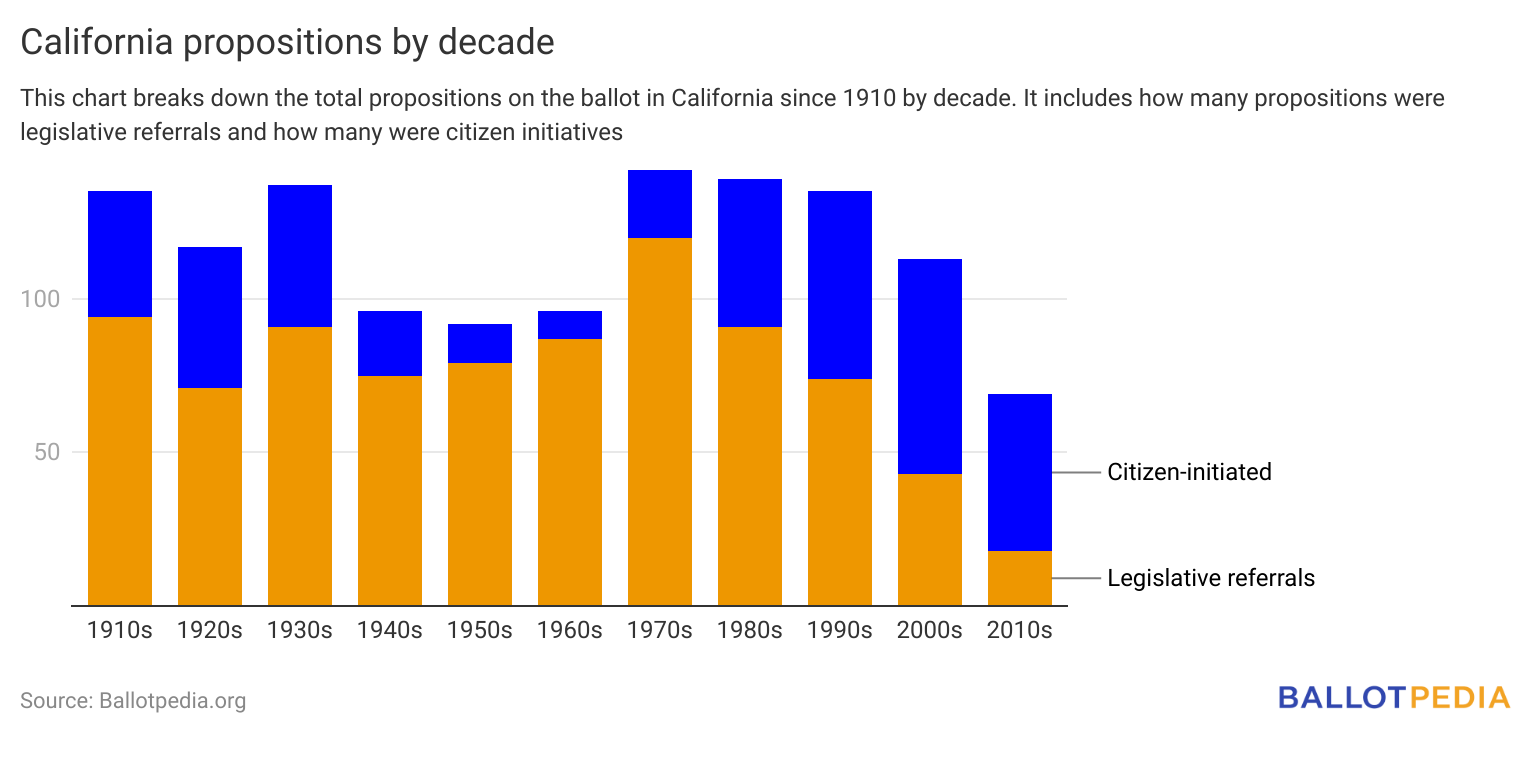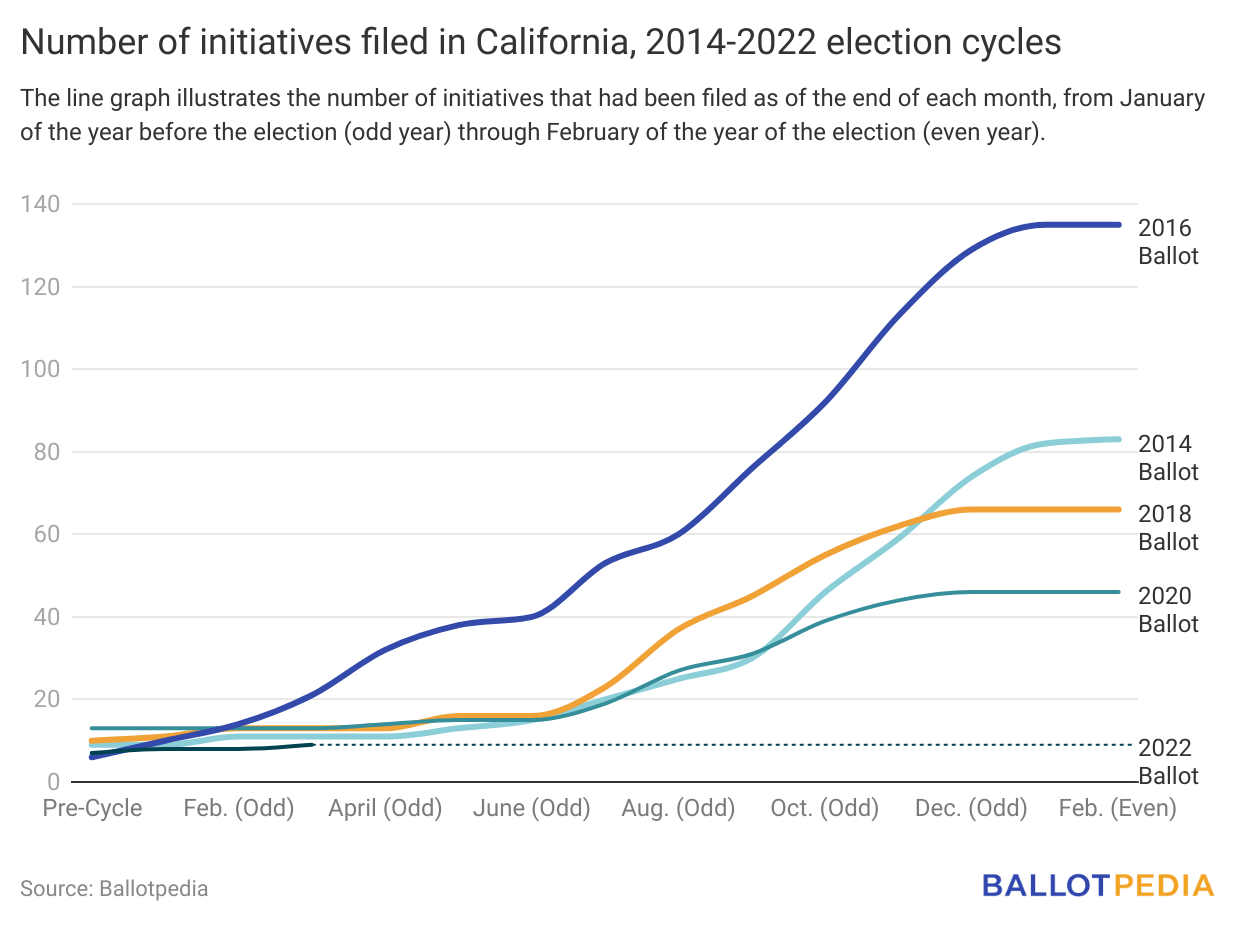|
|
 |
|
|
The current state of ballot measures
|
|
|
March 28, 2021
|
|
|
|
Happy Sunday! We hope you are having a nice weekend. Thanks for letting us into your inbox for this special exploration into the current state of ballot measures. We hope you enjoy it - and if there’s anything that piques your curiosity, just reply; we’d love to hear it. |
|
|
|
BALLOTPEDIA |
|
|
|
|
|
|
So far, 12 statewide measures have been certified for the 2022 ballot in nine states, which is about average for this point in the cycle.
|
|
|
|
|
|
|
|
Two of those measures are certified for the ballot in California, and both were put on the ballot through signature petition drives. California is one of the most active states for ballot measures, typically drawing the most overall spending and often the highest number of total measures appearing before voters. Today let’s look closer at how California’s 2022 ballot measures are shaping up, as well as diving into some historical context. |
|
|
|
|
|
|
California Ballot Measures Update: Looking Ahead to 2022
|
|
|
|
|
|
|
It’s been 110 years since California became the 10th state to adopt a process for putting statewide measures on the ballot through citizen signature petitions. Voters have decided 436 citizen-initiated measures—including both ballot initiatives and veto referendums—in California since 1911. That’s an average of 8 measures per two-year election cycle. Last decade (2010 - 2019) had an average of 10.2 measures per election cycle.
Including legislative referrals, California voters have decided 1,284 statewide ballot measures since 1911. Citizen-initiated measures made up 34% of the total.
 |
|
|
|
|
So far, a low number of proposals
|
|
|
|
|
|
|
We’re three months into the 2022 election cycle, and nine citizen-initiated measures have been filed, including three that carried over from the 2020 cycle. That’s a below-average trend thus far. From 2013 to 2019, an average of 14.5 initiatives were filed during or before March in the odd-numbered year preceding the general election. If the current trend was to continue, about 55 initiatives would be proposed for 2022. Because an average of 12% of proposals make the ballot in California, the current trend would project 6 or 7 citizen-initiated measures in 2022.
Among all 26 states with processes for statewide citizen-initiated measures, an average of 7.3% of filed measures made the ballot since 2010.
However, we’re still early in the election cycle. The ongoing COVID-19 pandemic could be a reason current filings are low and a change in infection rates or regulations could encourage more filings later on. Since 2014, more than half of all proposals that make the ballot in California are filed between August and November of the odd-numbered year preceding the general election.
 |
|
|
|
|
Coronavirus caused several campaigns to file signatures too late for 2020
|
|
|
|
|
|
|
|
California was one of 13 states in which ballot initiative campaigns suspended their signature drives in response to the pandemic. Three campaigns originally intended to file signatures in time for their initiatives to be placed on the Nov. 3 2020 ballot, but they missed the April deadline. All of these campaigns ended up filing signatures at a later date. One has had its signatures certified, while local elections offices are currently conducting full checks of all signatures. These measures would appear on the 2022 general election ballot. |
|
|
|
|
|
|
What’s on the 2022 ballot
|
|
|
|
|
|
|
Two measures have been certified for the next general election.
-
Changes to Medical Malpractice Lawsuits Cap Initiative: This initiative would increase California's $250,000 cap on noneconomic damages in medical malpractice lawsuits based on changes in inflation since 1975. It would also allow judges and juries to award damages above the cap for catastrophic injuries. Trial Lawyers for Justice and Consumer Watchdog are backing the initiative. The campaign could have filed signatures for the 2020 ballot, but decided to hold onto them for an additional week past the deadline. Scott Olsen, a board member of Consumer Watchdog, said, "While we are constantly hearing from more Californians harmed by medical negligence who have been denied accountability because of this 45-year-old law, it will be more productive to have this conversation when everything stabilizes.”
-
Flavored Tobacco Products Ban Referendum: Voters will also decide a veto referendum to overturn a flavored tobacco ban, a first-of-its-kind ballot measure at the state level. The California Coalition for Fairness is campaigning for the veto referendum to repeal SB 793. Through Dec. 31, 2020, the campaign raised $21.1 million, including $10.3 million from R.J. Reynolds Tobacco Co. and $9.8 million from Philip Morris USA.
|
|
|
|
|
|
|
Stay up-to-date on ballot measure certifications and news
|
|
|
|
|
|
|
|
The State Ballot Measure Monthly, is an email series that tracks ballot measure certifications and the news that surrounds them on a monthly basis. Click here to sign up for this free report. |
|
|
|
|
|